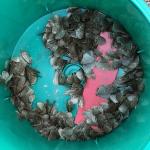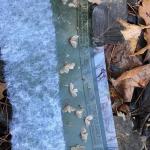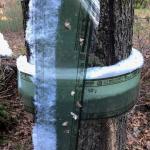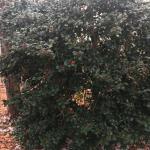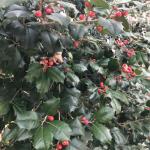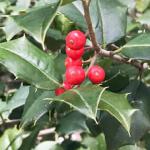A monthly e-newsletter from UMass Extension for landscapers, arborists, and other Green Industry professionals.
To read individual sections of the message, click on the section headings below to expand the content:
Hot Topics
New England Greenhouse Webinar Series
Looking for information on growing helathy plugs and rooted cuttings? Check out the lastest webinar from the New England Greenhouse webinar series on Growing Healthy Roots.
UMass Garden Calendar Photo Contest
Ever take a great garden photo and think “this would be perfect for the UMass Garden Calendar?” We are pleased to announce that we are now accepting photos submitted by the public. Submissions will be judged by the calendar team at UMass Extension and may earn a spot in the 2019 Garden Calendar. For more information visit the Garden Calendar page.
Ticks are active at this time!
Remember to take precautions when working outdoors and to conduct daily tick checks. The UMass Amherst Laboratory of Medical Zoology tests ticks for Lyme Disease and other tick-borne pathogens. Visit the Tick Report website for more information.
Questions & Answers
Q: Why do the leaves of Rhododedron sometimes curl in the winter?
A: Thermonasty is plant movement in response to an external factor such as temperature, wind, or light. There have been many logical theories why the leaves of evergreen Rhododendron species curl and droop in the winter including to reduce snow load damage or to reduce desiccation. Neither of these theories are the correct reason as Rhododendron leaves are generally not damaged even with the buildup of snow or ice. Avoidance of desiccation is also not correct as leaf stomata do not open in the cold and Rhododendron leaves have a thick cuticle that limits water loss.
Research has shown that Rhododendron leaf curling and leaf drooping are actually two separate responses to environmental factors. Leaf drooping, or the changing of leaf angle, is likely to prevent damage due to the combination of high light levels and cold temperatures. Many evergreen plants are exposed to higher light levels in winter because the deciduous plants that normally shade them have dropped their leaves. The plants are not able to dissipate the light energy which can lead to damage to chloroplast membranes.
Leaf curling is a response to avoid damage due to freeze-thaw cycles. Rhododendron leaves generally freeze at night and thaw during the day. If the leaves rapidly thaw after freezing, cellular damage is likely to occur because ice crystals can pierce cellular membranes. Research has shown that damage is reduced if leaves slowly rewarm. Leaf curling reduces the leaf area exposed to sunlight; therefore reducing the rate of thaw, preventing damage. Leaf curling occurs at a narrow temperature range above freezing.
Q: Why do my Siberian carpet cypress turn a bronze-purple color in the winter?
A: Leaves or needles of evergreen plants can turn purple, bronze, or red in winter when they are growing in high light environments. This color is due to the production of a pigment called anthocyanin which acts as a sort of sunscreen for plants in winter. Evergreen plants still phosynthesize in winter, but the cold temperatures mean that plants are not functioning as quickly as during warmer months. The high light level and reduced rate of metabolic reactions means that plants are at risk for photinhibition, or a decrease in the capacity for or efficiency of photosynthesis, and need protection. Anthocyanins are the same pigment that can give deciduous plants red or purple fall color.
For more information:
Arnoldia article on Rhododendron leaf curl
Mandy Bayer, Extension Assistant Professor of Sustainable Landscape Horticulture, University of Massachusetts Amherst
Trouble Maker of the Month
Winter Moth Numbers at a Record Low: Promising Data from the Elkinton Lab
It’s that time of year again, following the emergence of winter moth (Operophtera brumata) adult moths, where anyone with vested interest in the health of oak, maple, apple, and many other deciduous plants such as cherry, basswood, ash, white elm, crabapple, and blueberry, begin to wonder what is currently known about the winter moth population in Massachusetts.
Dr. Joseph Elkinton, Professor of Environmental Conservation at the University of Massachusetts, Amherst, MA, has excellent news for us all: data from his lab’s research locations in eastern Massachusetts suggest that this invasive pest’s population size is at an all-time low. In fact, the 2017 winter moth population was the lowest they have seen since studying and working toward the biological control of this insect for the past 13 years. Hopefully, this will mean low winter moth caterpillar numbers for the 2018 season, in most areas where they are present in eastern Massachusetts.
Winter moth outbreaks and subsequent defoliation of the above-mentioned host plants were first noticed in Massachusetts on Cape Ann on the North Shore and near Cohasset, Hingham, and Rockland on the South Shore in the late 1990’s. At the time, this defoliation was thought to be caused by a native insect. However, the persistence and severity of the outbreak in Plymouth County caused Deborah Swanson, UMass Extension Horticulturist for Plymouth County, Retired, to send caterpillars to UMass Extension Entomologist Robert Childs and Dr. Elkinton to further investigate what species could be responsible.
In 2003, following a collaborative effort with UMass Extension and Plymouth County Extension, Dr. David Wagner of the University of Connecticut and Richard Hoebeke of Cornell University confirmed that winter moth (Operophtera brumata) was responsible. Over the next decade, winter moth caused defoliation spread over all of the North Shore into the western suburbs of Boston and across the South Shore onto Cape Cod and Martha’s Vineyard and into Rhode Island and coastal Maine.
Winter moths overwinter in the egg stage, hidden in the cracks and crevices of bark or under lichen on host plants. Eggs are tiny and difficult to see without magnification. Each female moth may lay 150-350 of these eggs, which are initially green but quickly turn a red-orange color. In March, prior to hatching, eggs will turn bright blue and then dark blue-black. It is believed that egg hatch in Massachusetts occurs when 20–50 Growing Degree Days1 (base 50º F) have accumulated, which can be anywhere from late March into early-mid April, depending on the year and the location. (The Elkinton lab at UMass uses a base 40º F when completing Growing Degree Day calculations for this insect and suggests that hatch occurs between 177 and 243 GDD (base 40°F).2)
In most years, egg hatch coincides with bud break of the host plants. Tiny winter moth caterpillars will crawl up tree trunks and branches toward these buds and if the bud has expanded enough, they can wriggle their way inside and begin feeding, even prior to leaf expansion. These caterpillars cannot chew their way into closed buds, but once buds open and they enter, they are capable of significant damage to the host plant leaves, which will later expand and reveal shot hole-like damage. Like gypsy moth caterpillars, winter moth caterpillars are capable of dispersing using a technique referred to as “ballooning”. A strand of silk is spun and the lightweight larvae use the wind to be blow haphazardly toward host plants. Once the inchworm-like caterpillars are full-grown (approximately one inch in length), they drop to the soil to pupate, usually in late May, where the pupae remain until late fall.
Adult winter moths usually begin to emerge around Thanksgiving, or earlier, as evidenced last fall on November 16, 2017, as reported by Deborah Swanson (UMass Extension Horticulturist for Plymouth County, Retired) in Hanson, MA. Adult emergence continues through December and even into January, whenever air temperatures are mild (above freezing) and the ground remains unfrozen. Small, light brown male moths can be seen flying around, often attracted to porch lights or other outdoor light sources. Females are wingless and cannot fly; they crawl up tree trunks and release a pheromone to attract males for mating.
Since 2005, Dr. Elkinton and his laboratory, with the help of dedicated volunteers, have managed the large task of collecting, releasing, and monitoring the efficacy of Cyzenis albicans, a tachinid fly parasitoid of the winter moth as a biological control agent attacking winter moth (C. albicans can only successfully develop in winter moth). This fly was originally from Europe and had previously been established, in other North American locations such as Nova Scotia in the 1950’s, with much success in reducing outbreak populations of winter moth to a non-pest status. The female fly (Cyzenis albicans) lays its eggs (up to 1,000 of them) on host plant foliage of the winter moth, and while feeding, winter moth caterpillars will eat the eggs of the flies. The egg will hatch and a tiny fly maggot will lie in wait, inside the immature winter moth, until the caterpillar is done feeding and drops to the ground to pupate. The immature fly maggot will then complete its development inside of the winter moth pupa, where it will remain until the following spring.
In the spring, at approximately the same time winter moth eggs hatch, the flies (Cyzenis albicans) emerge from the deceased caterpillar pupae in the soil, mate, and lay more eggs for more caterpillars to ingest. There is one generation of flies per year.
To collect the fly, Elkinton’s lab manager George Boettner traveled each April-May for seven years to Vancouver Island in British Columbia where both winter moth and the fly were established in the 1970’s. At that location, he managed a crew of helpers who collected many thousand winter moth caterpillars over about a one-month period. About half of the winter moth caterpillars they collected had the fly larva inside them. The flies were then reared to the pupal stage in the laboratory in Massachusetts and the adult flies released at various locations the following spring.
To date, the Elkinton lab has released Cyzenis albicans at 43 sites in MA, CT, RI, and ME. The fly has been established at 32 of those locations and the Elkinton lab has evidence of its ability to spread throughout the local winter moth population at those sites from the initial point of release. They now have data for sites located in Falmouth, Hanson, Hingham, Wellesley, Wenham, and Yarmouth, MA indicating that parasitism of winter moth pupae by C. albicans ranges from 15-48%. Typically, this might not be high enough of a percentage to reduce a pest population, but in the case of winter moth – that is what the data shows at these locations. As parasitism rates for the tachinid fly increase, the density of healthy winter moth pupae decreases.
So how are these tachinid flies able to have such an impact on the winter moth population at this time? Data collected by the Elkinton lab shows that native predators in Massachusetts prey heavily on winter moth pupae in the soil where they reside between May and November. At their research sites, Hannah Broadly, one of Dr. Elkinton’s PhD students, has trapped and identified 29 species of predatory ground beetles (Carabidae) feeding on winter moth pupae. She has also identified what may be a previously undescribed (unknown to science) parasitoid wasp in the genus Pimpla (Family: Ichneumonidae). With the help of taxonomic collaborators, she is currently working to determine if this is a new species or whether it corresponds to one that has been previously described.
It would seem at this time, the decline currently seen in the winter moth population may be a combination of the impact of Cyzenis albicans, predators present in the environment, and parasitoids such as this Pimpla spp. coupled with abiotic factors. For example, recent warm springs have led to early egg hatch of the winter moth, and in some cases were followed with a cold snap lasting a week or so. In situations such as those, bud expansion may be delayed in which case young caterpillars cannot wriggle their way in to feed, and subsequently starve. Overall, the decrease in winter moth larvae, pupae, and adults seen in 2017 is a welcome sight for many in eastern Massachusetts and we certainly hope this trend continues!
For more information about winter moth, please visit the UMass Extension Winter Moth Fact Sheet or the History and Biological Control of Winter Moth Fact Sheet.
1Growing degree day information is available in the Landscape Message for areas throughout Massachusetts, using a base 50ºF. For more information on how to calculate growing degree days, please visit this fact sheet.
2The Elkinton lab at UMass uses a base 40º F when completing Growing Degree Day calculations for this insect and suggests that hatch occurs between 177 and 243 GDD (base 40°F, January 1 start date, double sine method). Resources such as uspest.org will allow you to manipulate how GDD’s are calculated, including using a base 40ºF and different mathematical models. The reason for using Base 40 is that 40ºF is very close to the minimum temperature for winter moth development and considerable GDD accumulation occurs between 40-50ºF. Predicting hatch with GDD’s is imperfect for this insect, however. Research in the Elkinton lab and in Europe has shown that later springs with older eggs require fewer GDD to hatch.
Dr. Joseph Elkinton, Professor of Environmental Conservation at UMass Amherst and Tawny Simisky, Entomology Specialist at UMass Extension
Plant of the Month
Ilex opaca, American Holly
American holly is a slow growing broadleaf evergreen tree with a beautiful densely pyramidal growth habit. It is native to the eastern and central US and is hardy zones 5 to 9. Trees grow to a height of 15 – 30’ and offer clusters of red berries that persist throughout fall and winter. Leaves are alternate 1½ - 3½ inches in length, dark green in color with widely spaced, spine tipped teeth.
Ilex opaca blooms in June and produces white flowers. Male flowers are borne in groups of three or more clusters and female flowers are solitary. Male and female flowers are on separate trees. One male tree should be planted for every three female trees to ensure production of berries on female trees.
American holly prefers moist, acidic, loose well-drained soil. In alkaline soils, plants are susceptible to leaf chlorosis due to high soil pH. Plants can tolerate a broad range of soil conditions, but will not tolerate flooding or soils saturated with moisture. American holly grows in sun or partial shade but berry production is best in full sun. Plants will benefit from protection against desiccating winter sun and winds.
The major pest problems of American holly are leaf miner and scale. Other problems include spider mites, whitefly beetles and diseases such as anthracnose, leaf spot, bacterial blight, twig die back and leaf scotch. American holly can be used as a specimen tree, in small groupings, as a large hedge or tall screen, or for foundation plantings. It is also popular for Christmas wreaths and decorations, and berries are good winter food source for birds in the winter.
There are many cultivars of American holly available, selected for superior appearance and utility such as bright fruit displays, attractive leaves and dense habit. Cultivars are region specific, so, when selecting a cultivar, it is important to choose from those recommended for northern climates. Cultivars include:
- 'Jersey Princess': considered one of best fruiting cultivars
- 'Jersey Knight': good pollinator
- 'Steward’s Silver Crown': variegated cultivar slowing growing to 25’; female
- 'Croonenburg': bears both female and male flowers on the same plant; columnar form
Geoffrey Njue, Green Industry Sustainability Specialist, UMass Extension
Upcoming Events
Landscape Safety Conference
Have you ever been bitten by a mosquito? Removed an attached tick? Encountered a poisonous plant? Do you work with pesticides? If you answered “YES” to any of these questions, this Landscape Safety Conference is for you. This program will explore many topics that are important for landscapers, arborists, tree wardens, lawn care professionals, grounds managers, and essentially any professionals working in outdoor environments. UMass Extension and speakers from the MA Dept. of Agricultural Resources and the UMass Laboratory of Medical Zoology will come together to provide this day-long program. Topics include mosquito and tick prevention and safety; tick testing services provided by the Laboratory of Medical Zoology; poisonous plants you are likely to encounter and strategies to keep yourself safe; pesticide storage, transportation, and use safety; and PPE when working with pesticides.
- When: Tuesday February 6, 2018; 8:30am-3:30pm
- Where: Doubletree Hotel, Milford, MA
- Registration
Invasive Plant Certification Program
In the last several years, there has been growing interest in invasive plants and their management. While turf and landscape professionals might be very proficient in the development of a weed management program for turf and/or landscape, invasive plant management often reveals many new and unique challenges. This 4-day program is intended to help participants meet these challenges when attempting to develop an invasive plant management program as part of their business. A certificate in INVASIVE PLANT MANAGEMENT may be obtained by attending all four sessions and obtaining a passing grade for each (each session may also be taken individually). These are:
-
February 21, 2018 - Principles and Fundamentals of Weed Science (A1)
-
March 13, 2018 - State Regulations Pertaining to Invasive Plant Management (A2)
-
March 22, 2018 - The Invasive Plant Issue and Invasive Plant Identification (A3)
-
April 4, 2018 - Developing an Invasive Plant Management Program (B)
-
Where: Hadley Farms Meeting House, Hadley, MA
Other Upcoming Events:
- 2/6: Landscape Safety Conference
- 2/21: Principles and Fundamentals of Weed Science
- 3/5: (NOTE CHANGE OF DATE) 39th Annual UMass Community Tree Conference: Ecological Perspectives of the Urban Forest
- 3/13: State Regulations Pertaining to Invasive Plant Management
- 3/22: The Invasive Plant Issue and Invasive Plant Identification
- 3/29: Spring Kickoff for Landscapers: UMass Extension Landscape Education Day
For more information and registration for any of these events visit the UMass Extension Landscape, Nursery, and Urban Forestry Program Upcoming Events Page.
Additional Resources
For detailed reports on growing conditions and pest activity – Check out the Landscape Message
For commercial growers of greenhouse crops and flowers - Check out the New England Greenhouse Update website
For professional turf managers - Check out Turf Management Updates
For home gardeners and garden retailers - Check out home lawn and garden resources. UMass Extension also has a Twitter feed that provides timely, daily gardening tips, sunrise and sunset times to home gardeners, see https://twitter.com/UMassGardenClip
Diagnostic Services
A UMass Laboratory Diagnoses Landscape and Turf Problems - The UMass Extension Plant Diagnostic Lab is available to serve commercial landscape contractors, turf managers, arborists, nurseries and other green industry professionals. It provides woody plant and turf disease analysis, woody plant and turf insect identification, turfgrass identification, weed identification, and offers a report of pest management strategies that are research based, economically sound and environmentally appropriate for the situation. Accurate diagnosis for a turf or landscape problem can often eliminate or reduce the need for pesticide use. For sampling procedures, detailed submission instructions and a list of fees, see Plant Diagnostics Laboratory
Soil and Plant Nutrient Testing - The University of Massachusetts Soil and Plant Nutrient Testing Laboratory is located on the campus of The University of Massachusetts at Amherst. Testing services are available to all. The function of the Soil and Plant Nutrient Testing Laboratory is to provide test results and recommendations that lead to the wise and economical use of soils and soil amendments. For complete information, visit the UMass Soil and Plant Nutrient Testing Laboratory web site. Alternatively, call the lab at (413) 545-2311.

